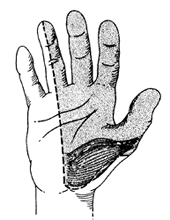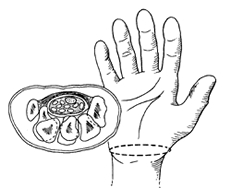Home | Education | Nerve Conditions | Carpal Tunnel Syndrome
Dr. Smith provides a comprehensive multidisciplinary approach for the evaluation, treatment and care of carpal tunnel syndrome.
Carpal Tunnel Treatment and Surgery
By Houston Hand Surgery Specialist & Orthopaedic Surgeon, Dr. Dean Smith
Carpal tunnel syndrome is a condition brought on by increased pressure or a pinched nerve at the wrist. Symptoms may include numbness, tingling, and pain in the arm, hand, and fingers. There is a space in the wrist called the carpal tunnel where the median nerve and nine tendons pass from the forearm into the hand (see Diagram 2). Carpal tunnel syndrome happens when pressure builds up from swelling in this tunnel and puts pressure on the nerve. When the pressure from the swelling becomes great enough to disturb the way the nerve works, numbness, tingling, and pain may be felt in the hand and fingers (see Diagram 1).Carpal Tunnel Syndrome Causes
Usually the cause is unknown. Pressure on the nerve can happen several ways: swelling of the lining of the flexor tendons, called tenosynovitis; joint dislocations, fractures, and arthritis can narrow the tunnel; and keeping the wrist bent for long periods of time. Fluid retention during pregnancy can cause swelling in the tunnel and symptoms of carpal tunnel syndrome, which often go away after delivery. Thyroid conditions, rheumatoid arthritis, and diabetes also can be associated with carpal tunnel syndrome. There may be a combination of causes.Symptoms of Carpal Tunnel Syndrome
Carpal tunnel syndrome symptoms usually are pain, numbness, tingling, or a combination of the three. The numbness or tingling most often takes place in the thumb, index, middle, and ring fingers. The symptoms usually are felt during the night but also may be noticed during daily activities such as driving or reading a newspaper. Patients sometimes notice they have a weaker grip, occasional clumsiness, and may drop things. In severe cases, sensation may be permanently lost, and the muscles at the base of the thumb slowly shrink (thenar atrophy).Diagnosis of Carpal Tunnel
A detailed history including medical conditions, how the hands have been used, and whether there were any prior injuries is important. An X-ray may be taken to check for other causes of the complaints such as arthritis or a fracture. In some cases, laboratory tests may be done if there is a suspected medical condition that is associated with CTS. An NCV or nerve conduction study and EMG or electromyogram may be done to check for other sites of nerve problems as well as to evaluate the carpal tunnel.Non-surgical Treatment for Carpal Tunnel Syndrome
Symptoms can often be relieved without surgery. Identifying and treating medical conditions, changing the patterns of hand use, or keeping the wrist splinted in a straight position may help reduce pressure on the nerve. Wearing wrist splints at night may relieve the symptoms that interfere with sleep. Anti-inflammatory medication taken by mouth or injected into the carpal tunnel may help relieve the carpal tunnel symptoms.Carpal Tunnel Surgery
When symptoms are severe or do not improve, surgery may be needed to make more room for the nerve. Pressure on the nerve is decreased by cutting the ligament which forms the roof (top) of the tunnel on the palm side of the hand (see Diagram 3). Incisions for this surgery may vary, but the goal is the same — to enlarge the tunnel and decrease pressure on the nerve. Dr. Smith performs minimally invasive and endoscopic carpal tunnel releases as his primary procedure of choice. Following surgery, soreness around the incision may last for several weeks or months. The numbness and tingling may disappear quickly or slowly. It may take several months for strength in the hand and wrist to return to normal. Carpal tunnel symptoms may not completely go away after surgery, especially in severe cases.Dr. Smith provides a comprehensive multidisciplinary approach for the evaluation, treatment and care of carpal tunnel syndrome.
 |
Diagram 1 Aspects of median nerve function. |
 |
Diagram 2 The carpal tunnel is found at the base of the palm. It is formed by the bones of the wrist and the transverse carpal ligament. Increased pressure in the tunnel affects the function of the median nerve. |
 |
Diagram 3 The goal of surgery is to free the ligament to allow more room for the median nerve in the carpal tunnel. |
Call Dr. Smith at 713-524-0580 to schedule an appointment concerning Carpal Tunnel Treatment and Surgery.
The information on this webpage is based on material from the American Society for Surgery of the Hand and is for educational purposes only.